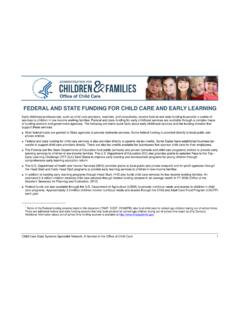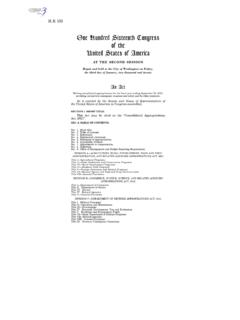Transcription of Publication 5307 (Rev. 6-2020) - IRS tax forms
1 Tax reform basics for individuals and families PUBLICATION5307 TAX YEAR 2019 Publication 5307 (Rev. 6-2020) Catalog Number 71626U Department of the Treasury Internal Revenue Service of ContentsOverview of the Tax Cuts and Jobs Act ..1 What s New for Tax Year 2019? ..1 Health care coverage, coverage exemption and shared responsibility payment ..1 Repeal of deduction for alimony payments ..1 Deduction for medical and dental expenses modified by Public Law 116-94 ..1 Changes in Tax Rates ..1 Federal Income Tax Withholding May Need Adjustment ..2 Paycheck Checkup ..2 Updating form W-4 After Doing a Paycheck Checkup ..3 Making Estimated or Additional Tax Payments ..3 Changes to Standard Deduction ..4 Changes to Itemized Deductions ..4 Limit on overall itemized deductions suspended..5 Deduction for medical and dental expenses modified..5 Deduction for state and local income, sales and property taxes modified.
2 5 Deduction for home mortgage and home equity interest modified..5 New dollar limit on total qualified residence loan balance..6 Limit for charitable contributions modified..6 Deduction for casualty and theft losses modified..6 Miscellaneous itemized deductions suspended..7 Deduction and Exclusion for moving expenses suspended ..7 Changes to Benefits for Dependents ..7 Deduction for personal exemptions suspended ..7 Child tax credit and additional child tax credit ..8 Credit for other dependents ..8 Social security number required for child tax credit ..8 Alternative minimum tax (AMT) exemption amount increased ..8 Repeal of deduction for alimony payments ..9 Treatment of student loans discharged on account of death or disability modified ..9 Repeal of deduction for amounts paid in exchange for college athletic event seating rights ..9 Combat zone tax benefits available to Armed Forces members who served in the Sinai Peninsula.
3 9 Reporting Health Care Coverage ..9 Retirement Plans ..10 Recharacterization of a Roth Conversion ..10 Plan Loans to an Employee that Leaves Employment ..10 Disaster Relief Retirement Plans ..10 ABLE Accounts Rollovers from a 529 Plan ..10 ABLE Accounts - Saver s Credit now Available for Contributions ..10 ABLE Accounts Changes for People with Disabilities ..10529 Plans - K-12 education ..10 Reminders ..11 Resources ..111 TAX reform basics FOR individuals & FAMILIESO verview of the Tax Cuts and Jobs Act Major tax reform that affects both individuals and businesses was enacted in December 2017. It s commonly referred to as the Tax Cuts and Jobs Act, TCJA or tax reform . Most of the changes in this legislation were effective in 2018 and affect tax year 2018 and beyond. The IRS collaborates with the tax professional community, industry, and tax software partners each year as we implement changes to the tax law, including the Tax Cuts and Jobs Act, to ensure that our shared customer you, the taxpayer - has information about how the law applies to your particular situation and you are prepared to file.
4 Using tax preparation software is the best and simplest way to file a complete and accurate tax return. The software guides you through the process and does all the math. Electronic filing options include IRS Free File for taxpayers who qualify, Free File Fillable forms for all taxpayers, commercial software, and professional assistance. The IRS Volunteer Income Tax Assistance (VITA) and the Tax Counseling for the Elderly (TCE) programs offer free tax help and e-file for taxpayers who Publication covers some of the provisions of the TCJA. It provides information for you and your family to help you understand, take action - if necessary - and comply with your federal tax return filing is not intended to replace or supersede IRS tax forms , instructions or other official official IRS .gov website includes a Tax reform page that highlights what you need to know about the tax law changes. This page also provides links to news releases, publications, notices, and legal guidance related to the legislation.
5 What s New for Tax Year 2019?Health care coverage, coverage exemption and shared responsibility paymentUnder the Tax Cuts and Jobs Act, the amount of the individual shared responsibility payment is reduced to zero for months beginning after December 31, 2018. Beginning in tax year 2019, form 1040 will not have the full-year health care coverage or exempt box and form 8965, Health Coverage Exemptions, will no longer be used. You need not make a shared responsibility payment or file form 8965, Health Coverage Exemptions, with your tax return if you did not have minimum essential coverage for part or all of 2019. Repeal of deduction for alimony payments You can t take a deduction for alimony payments you made to or for your former spouse if you executed your divorce or separation agreement after December 31, 2018, or if the agreement was executed on or before December 31, 2018, and was changed after December 31, 2018, to expressly provide that the TCJA provision on alimony applies to the alimony paid and received under the changed agreement.
6 See Publication 504, Divorced or Separated individuals for more for medical and dental expenses modified by Public Law 116-94. If you plan to itemize deductions, the adjusted gross income (AGI) threshold for deducting medical and dental expenses is percent for all taxpayers for taxable years ending after 2018 and beginning before 2021 ( , for TY 2019 and for TY 2020). Changes in Tax RatesFor 2018 through 2025, most tax rates have been reduced. This means most people will pay less tax than they did for 2017 and earlier years. The 2019 tax rates are 10%, 12%, 22%, 24%, 32%, 35%, and 37%.In addition to lowering the tax rates, some of the changes in the law that affect you and your family include increasing the standard deduction, suspending personal exemptions, increasing the child tax credit, and limiting or discontinuing certain reform basics FOR individuals & FAMILIESF ederal Income Tax Withholding May Need AdjustmentThe Tax Cuts and Jobs Act changed the way taxable income is calculated and reduced the tax rates on that IRS had to address and make changes to income tax withholding in response to the new law as soon as possible after it passed.
7 This issue affects every taxpayer who receives a paycheck. The tax system operates on a pay-as-you-go basis. Taxpayers must generally pay at least 90 percent of their taxes throughout the year through withholding, estimated or additional tax payments or a combination of the MEANS need to pay most of your tax during the year, as the income is earned or received. If you don t, you may owe an estimated tax penalty when you employees, income tax withholding is the amount of federal income tax withheld from your paycheck. The amount of income tax your employer withholds from your regular pay depends on two things: The amount you earn. The information you give your employer on form W 4, Employee s Withholding IRS completely redesigned the form W-4, Employee s Withholding Certificate, which is the IRS form that employees provide to their employers, so that the employer may determine the amount of federal income tax to withhold from the employees paychecks.
8 The form helps employees adjust withholding based on their personal circumstances, such as whether they have children or a spouse who is also working. The IRS recommends employees check their withholding any time their personal or financial information form W-4 relates to an employee s federal income tax withholding. State income tax withholding is MEANS still need to check and adjust your withholding annually and make sure it is correct so there is no surprise at tax filing as the amount of your withholding has changed based upon the change in tax rates, you may also need to adjust your withholding or make estimated or additional tax payments due to other changes in the tax law. You should review your withholding annually to make sure you don t have too little or too much withheld from your paycheck. To help with this, the IRS issued a Tax Withholding Estimator and updated form W-4 to help you check and update your withholding with your employer, if necessary.
9 You can use the estimator tool to estimate your income tax. Paycheck Checkup The Paycheck Checkup campaign encourages you to review your tax situation. The new tax law could affect how much tax someone should have their employer withhold from their paycheck. To help with this, taxpayers can use the Tax Withholding Estimator on to prevent employees from having too little or too much tax withheld from their paycheck. Having too little tax withheld can mean an unexpected tax bill and even a penalty at tax time. You might prefer to have less tax withheld up front and receive more in your paycheck which may mean a lower refund or an unexpected tax bill. Or, you might prefer to make estimated or additional tax payments to avoid an unexpected tax bill and possibly a should do an annual check of their withholding but this year is even more important, especially for taxpayers who: Belong to a two-income family.
10 Work two or more jobs or only work for part of the year. Have children and claim credits such as the Child Tax Credit. Have older dependents, including children age 17 or reform basics FOR individuals & families Itemized deductions on their prior year s tax returns. Earn high incomes and have more complex tax returns. Received large tax refunds or had large tax bills for the prior in personal circumstances can make it necessary for a taxpayer to increase income tax withholding. Taxpayers whose circumstances have changed, including those who have divorced, started a second job, or whose child is no longer their dependent, may need to submit a new form W-4 to their employer as soon as possible to have their withholding who work seasonal jobs or are employed part of the year should also perform a paycheck checkup. Any changes that a part-year employee makes to their withholding can affect each paycheck in a larger way than employees who work MEANS a checkup can help protect against having too little tax withheld and facing an unexpected tax bill and even a penalty at tax time.












